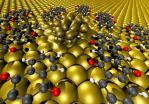(Press-News.org) Using powerful X-rays, University of British Columbia researchers have reconstructed a crime scene too small for any microscope to observe – and caught the culprit of arrhythmia in action.
Characterized by the heart beating too fast, too slow or inconsistently, arrhythmias may cause a decrease of blood flow to the brain and body, resulting in heart palpitation, dizziness, fainting, or even death.
Presented today at the 2013 Annual Meeting of the American Association for the Advancement of Science (AAAS) in Boston, the 3D animated model reveals for the first time how gene mutations affect the crucial pathway in heart muscle cells that controls its rhythm.
"Our heart runs on calcium," says UBC molecular biologist Filip Van Petegem. "Every heart beat is preceded by calcium ions rushing into heart muscle cells."
"Then, a special protein opens the pathway for calcium to be released from compartments within these cells, and in turn initiates the contraction."
Mutations to the gene that forms this protein have been linked to arrhythmia and sudden cardiac deaths in otherwise healthy people.
"Reconstructing the pathway and its dynamic motion enabled us to see the process in action," says Van Petegem. "We found that the mutations destabilize the pathway's structure, causing calcium to be released prematurely.
"Finding a way to stabilize the pathway could prevent these deadly conditions and save lives."
###
For more UBC news from AAAS 2013, visit http://aaas.ubc.ca or follow @ubcnews.
Arrhythmia culprit caught in action
2013-02-18
ELSE PRESS RELEASES FROM THIS DATE:
Food science expert: Genetically modified crops are overregulated
2013-02-18
CHAMPAIGN, Ill. — It has been almost 20 years since the first genetically modified foods showed up in produce aisles throughout the United States and the rest of the world, but controversy continues to surround the products and their regulation.
Bruce Chassy, a professor emeritus of food science and human nutrition at the University of Illinois at Urbana-Champaign, believes that after thousands of research studies and worldwide planting, "genetically modified foods pose no special risks to consumers or the environment" and are overregulated.
Chassy will elaborate on ...
Media advisory: AAAS session addresses city infrastructure design in a changing climate
2013-02-18
DURHAM, N.H. – As our climate changes, the way we engineer our cities must, too. That's the message that University of New Hampshire professor Paul Kirshen, an author of a recent report that assessed Boston's vulnerability to coastal flooding, will deliver at the American Association for the Advancement of Science (AAAS) Annual Meeting February 14-18, 2013, in Boston.
Kirshen will speak coastal adaptation planning for vulnerable communities in the "Environmental Challenges and Adaptation in Cities" session (3 – 4:30 p.m., Room 308, Hynes Convention Center). He'll present ...
Modern alchemy, fusion energy and more from Princeton
2013-02-18
A possible Higgs boson of cancer and steps to give natural biodiversity a fighting chance will be among the topics Princeton University researchers will discuss during the 2013 AAAS annual meeting. Below are summaries, arranged chronologically, of the research to be presented. All information is embargoed until the beginning of the respective session.
* Virtual water trade helps cope with climate change
Ignacio Rodriguez-Iturbe, James S. McDonnell Distinguished University Professor of Civil and Environmental Engineering
Friday, Feb. 15, 8 a.m., Room 203
Climate change ...
Synthetic molecule first electricity-making catalyst to use iron to split hydrogen gas
2013-02-18
RICHLAND, Wash. -- To make fuel cells more economical, engineers want a fast and efficient iron-based molecule that splits hydrogen gas to make electricity. Online Feb. 17 at Nature Chemistry, researchers report such a catalyst. It is the first iron-based catalyst that converts hydrogen directly to electricity. The result moves chemists and engineers one step closer to widely affordable fuel cells.
"A drawback with today's fuel cells is that the platinum they use is more than a thousand times more expensive than iron," said chemist R. Morris Bullock, who leads the research ...
Diamond sheds light on basic building blocks of life
2013-02-18
The UK's national synchrotron facility, Diamond Light Source, is now the first and only place in Europe where pathogens requiring Containment Level 3 – including serious viruses such as those responsible for AIDS, Hepatitis and some types of flu – can be analysed at atomic and molecular level using synchrotron light. This special light allows scientists to study virus structures at intense levels of detail and this new facility extends that capability to many viruses that have a major global impact on human and animal health. Studying pathogens in this way has the potential ...
Organic electronics -- how to make contact between carbon compounds and metal
2013-02-18
Until now, however, it was practically impossible to accurately predict which molecules performed well on the job. They basically had to be identified by trial-and-error.
Now, an international team of scientists around Dr. Georg Heimel and Prof. Norbert Koch from the HZB and the Humboldt University Berlin has unraveled the mystery of what these molecules have in common. Their discovery enables more focused improvements to contact layers between metal electrodes and active materials in organic electronic devices.
"We have been working on this question for a number of ...
'Activating' RNA takes DNA on a loop through time and space
2013-02-18
Long segments of RNA— encoded in our DNA but not translated into protein—are key to physically manipulating DNA in order to activate certain genes, say researchers at The Wistar Institute. These non-coding RNA-activators (ncRNA-a) have a crucial role in turning genes on and off during early embryonic development, researchers say, and have also been connected with diseases, including some cancers, in adults.
In an online article of the journal Nature, a team of scientists led by Wistar's Ramin Shiekhattar, Ph.D., detail the mechanism by which long non-coding RNA-activators ...
Dopants dramatically alter electronic structure of superconductor
2013-02-18
UPTON, NY - Over the last quarter century, scientists have discovered a handful of materials that can be converted from magnetic insulators or metals into "superconductors" able to carry electrical current with no energy loss-an enormously promising idea for new types of zero-resistance electronics and energy-storage and transmission systems. At present, a key step to achieving superconductivity (in addition to keeping the materials very cold) is to substitute a different kind of atom into some positions of the "parent" material's crystal framework. Until now, scientists ...
'Snooze button' on biological clocks improves cell adaptability
2013-02-18
The circadian clocks that control and influence dozens of basic biological processes have an unexpected "snooze button" that helps cells adapt to changes in their environment.
A study by Vanderbilt University researchers published online Feb. 17 by the journal Nature provides compelling new evidence that at least some species can alter the way that their biological clocks function by using different "synonyms" that exist in the genetic code.
"This provides organisms with a novel and previously unappreciated mechanism for responding to changes in their environment," said ...
Microbes team up to boost plants' stress tolerance
2013-02-18
UNIVERSITY PARK, PA. -- While most farmers consider viruses and fungi potential threats to their crops, these microbes can help wild plants adapt to extreme conditions, according to a Penn State virologist.
Discovering how microbes collaborate to improve the hardiness of plants is a key to sustainable agriculture that can help meet increasing food demands, in addition to avoiding possible conflicts over scare resources, said Marilyn Roossinck, professor of plant pathology and environmental microbiology, and biology.
"It's a security issue," Roossinck said. "The amount ...


